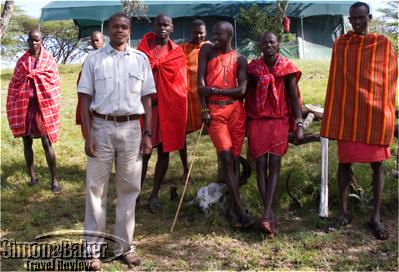
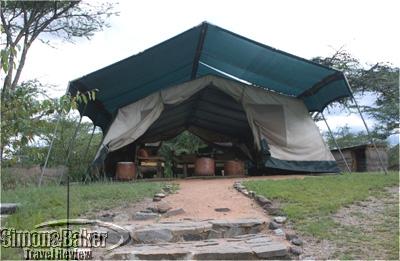
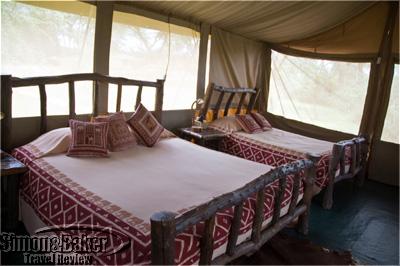
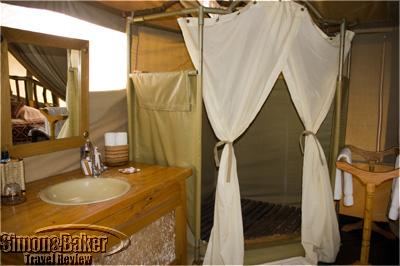
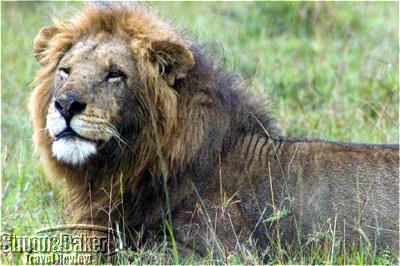
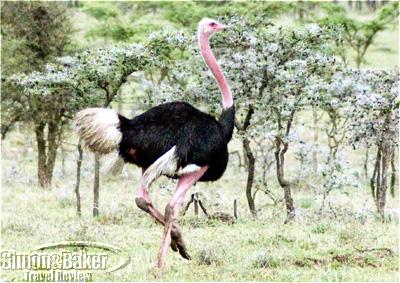
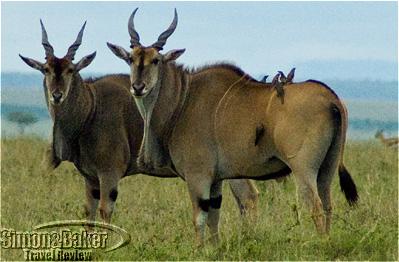
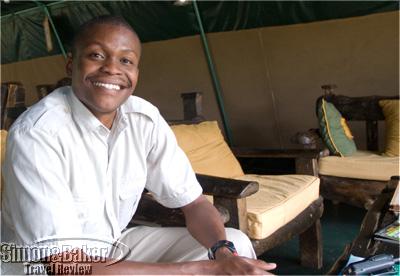
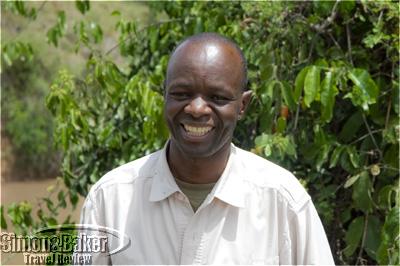
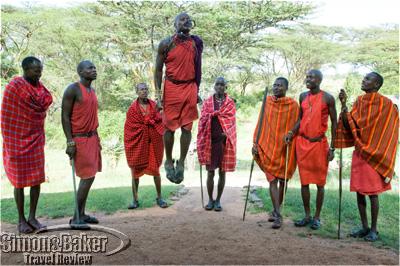
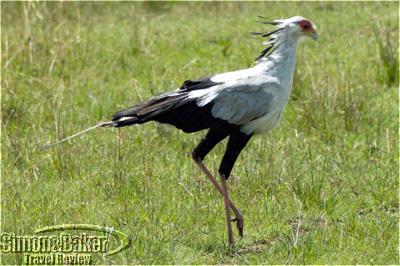
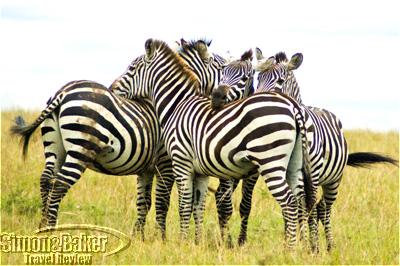
The 12-seater Cessna made a quick stop for me at the remote Siana Springs airstrip, where I was greeted by my guide John Adamba and spotter Marima. Within minutes we were rocking along a rough dirt road and across streams swollen by the onset of the autumn rains. This was Masai country at its most colorful, dotted with low bomas, fences of acacia branches encircling small villages of flat-roofed mud huts. Tall warriors in their blood-red robes went about their daily activities. Children waved at our open Land Rover before returning their attention to their herds. Soon the prairie became wooded rolling hills, and signs of human life vanished. Gazelles, antelopes and giraffes replaced cattle. What was meant to be a 25-minute ride to the camp became a leisurely game drive as John good humoredly stopped at every turn to let me photograph zebras defensively clustered in confusing patterns, or a new-born topi calf taking its first wobbly steps. Further on, Marima quietly pointed at a lioness concealed in the thicket.
At the camp, I was welcomed by manager Ernest Kavingo and the Masai staff members who immediately escorted me to my comfortably furnished, eco-friendly accommodation: a spacious tent with private bathroom, bush shower and solar electricity. Its large verandah overlooked the Laetoli, a permanent brook, and the bush beyond. But I didn’t linger, as it was already afternoon and hints of hunger drew me to the common tent where a delicious plated lunch awaited. This perfect balance of comfort, privacy and thoughtful pampering was the norm for the duration of my stay.
There were a variety of game viewing options, including game drives in the conservancy either as a destination, or as part of the day-long drive to the famous Masai Mara National Reserve, which was only 10 miles (17 kilometers) away. Within the conservancy, in addition to the wide variety of grazing animals and smaller predators, I was fortunate to observe at length members of the resident pride of lions, while night drives gave me the opportunity see nocturnal animals including a leopard. I also enjoyed an early morning botanical walk where a local Masai guide explored the local flora and fauna in more detail with me, and I enjoyed eye-level encounters with large herds of gazelles. The cooperative and exclusive venture between the owners of the camp, Gamewatchers Safaris, and the community-owned conservancy created a noticeable sense of partnership . As I was getting ready to depart, they gathered in front of the common tent and treated me to a farewell warriors’ dance. This genuine involvement on the part of the Masai staff, coupled with the close proximity to abundant game in this remote location, made my visit to Mara Porini Camp especially fulfilling and memorable.
Communications There was no Internet connection at the camp. Bluetooth and mobile phone service was unreliable. When available, it required a GSM 900/1800 compatible international cellular phone.
General Manager Ernest Kavingo
Handicapped Access No
Length Of Stay Three nights
Location In the Ol Kinyei Conservancy, northeast of the Masai Mara reserve in southwest Kenya. The nearest airstrip, Siana Springs, was nine miles (15 kilometers) away. The Ol Kinyei Conservancy was 155 miles (250 kilometers) from Nairobi by road, a journey that was estimated to take four to five hours.
Owned-Managed Gamewatchers Safaris and Jake Grieves-Cook was managing director
Power All electricity was solar generated. The tents had electric lighting, but not sufficient power to charge batteries. Batteries for cameras, telephones and laptops could be charged from a small solar-powered generator in the camp manager’s office tent.
Size The seven acre (three hectare) camp consisted of six guest tents capable of accommodating up to 12 guests. It employed a staff of 27, including three guides and three spotters.
Year Open-Renovated The camp opened in 2005. Since then it had been the object of meticulous on-going maintenance.
Room My 360 square foot (33.5 square meter) tent, Number five, sat two steps above ground on a wooden platform covered with weatherproof floor matting. At the front, the platform extended the width of the tent to form an awning-shaded deck that overlooked the brook. It was furnished with two directors chairs and a small coffee table. The tent entrance was the usual zippered “door.” Side walls were zip-up flaps over mosquito-netting covered “windows.” Inside, one queen-size and one double bed with rustic wooden headboards, each with its own bedside table and reading lamp occupied one side of the tent. The opposite side held a writing desk with a wooden chair, a luggage rack, a vertical canvas shelf and a clothes-hanging rod. The back wall separated the sleeping room from the bathroom. Cowhide floor rugs covered the floor matting. Indoor lighting was produced via solar electricity.
During my visit, I sighted: elephant, lion, leopard, serval cat, bat-eared fox, spotted hyena, banded mongoose, common duiker, Kirk’s dik dik, Grant’s gazelle, Thompson’s gazelle, kongoni, topi, wildebeest, hartebeest, impala, bushbuck, eland, buffalo, Masai giraffe, warthog, hippopotamus, Burchell’s zebra, vervet monkey, olive baboon. Birds included: Maasai ostrich, secretary bird, kory bustard, white-bellied bustard, lappet-faced vulture, black-chested snake eagle, lilac-breasted roller, yellow-billed hornbill, yellow-billed oxpecker, slender-tailed nightjar, African Hoopoe.
Shortly after my visit Porini Safari Camps and parent company Gamewatchers Safaris were honored with the Responsible Tourism Award for “Best for Conservation of Endangered Species outside Protected Area” at the World Travel Market in London. The award, sponsored by Virgin Holidays, recognized Porini/Gamewatchers “for demonstrating that a high revenue, low impact tourism development approach can benefit the local Masai through developing conservancies and tourism in partnership with safari companies to create employment and community income and to conserve their land for wildlife.”
Date Of Last Visit November 2008
Reviewers Article and photographs by Josette King
Service My tent was serviced twice daily, a morning cleaning and evening turn down service . Every member of the staff I encountered was attentive, friendly, helpful and well trained.
Would You Stay There Again? Yes
Contact Information
- Porini Safari Camps
- Village Market Complex
- P.O. Box 388-00621
- Nairobi, Kenya
- + 254 (20) 7123129
- + 254 (20) 7121851
- + 254 (20) 7122504
- + 254 (20) 7120864
